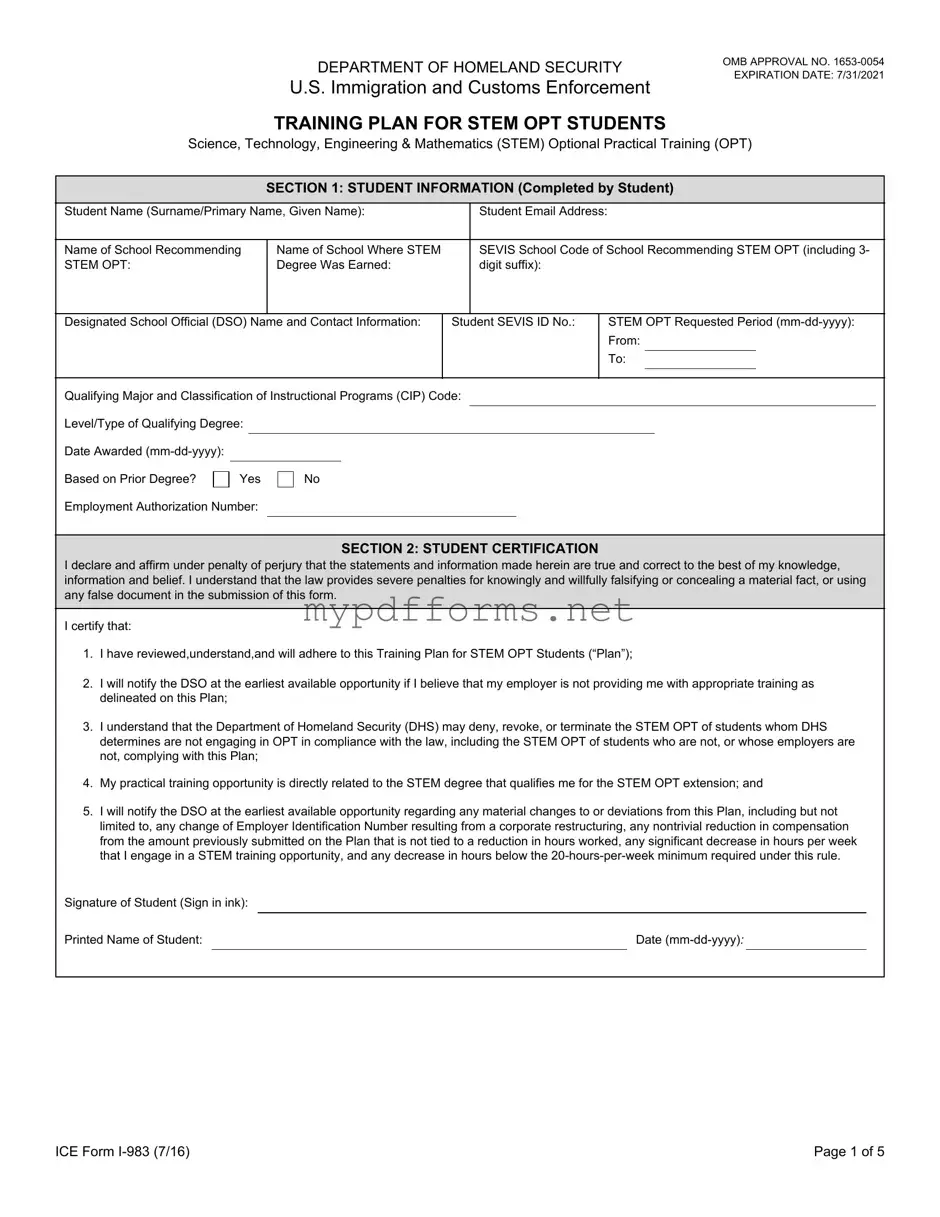The ICE I-983 form is similar to the Form I-20, which is used for international students in the United States. Both documents are essential for maintaining student status. The Form I-20 outlines the student's program of study and is required for obtaining an F-1 visa. Like the I-983, it must be signed by a designated school official and is crucial for ensuring compliance with immigration regulations. Both forms serve as a bridge between academic pursuits and practical training opportunities.
Another document comparable to the I-983 is the Form DS-2019, which is used for J-1 visa holders. This form facilitates participation in exchange visitor programs. Similar to the I-983, the DS-2019 outlines the purpose of the stay, the program sponsor, and the duration of the exchange. Both documents require signatures from authorized officials and are vital for maintaining legal status while engaging in training or educational activities in the U.S.
The Form I-765, Application for Employment Authorization, shares similarities with the I-983 in that both are related to work opportunities for non-immigrants. While the I-983 focuses on practical training, the I-765 is specifically for applying for permission to work. Both forms must be submitted to U.S. Citizenship and Immigration Services (USCIS) and require detailed information about the applicant's situation and purpose of work in the U.S.
The Form I-9, Employment Eligibility Verification, is another document that relates to the I-983 in terms of employment. Employers use the I-9 to verify the identity and employment authorization of their employees. While the I-983 is about training opportunities, the I-9 ensures that individuals are legally allowed to work in the U.S. Both documents play a crucial role in the employment process for non-citizens.
In addition to these essential documents, it is also important for individuals looking to establish a business to consider creating a Business Operating Agreement. This agreement provides clarity on the governance of the company and protects the interests of its members. To get started on creating your own Business Operating Agreement, it is advisable to have a thorough understanding of its components and how it aligns with business objectives.
The OPT (Optional Practical Training) application process is also similar to the I-983. Students seeking to work in their field of study after graduation must submit an application for OPT, which requires information about their training plan. Like the I-983, this process emphasizes the importance of aligning work experience with academic goals. Both documents help ensure that students follow the regulations set forth by immigration authorities.
The CPT (Curricular Practical Training) form is another document that resembles the I-983. CPT allows F-1 students to engage in work that is an integral part of their curriculum. Both forms require approval from a designated school official and outline the specifics of the training or employment. They ensure that the work experience is directly related to the student's field of study, thereby maintaining compliance with visa requirements.
The Form G-28, Notice of Entry of Appearance as Attorney or Accredited Representative, is relevant in the context of the I-983 when legal representation is involved. While the I-983 focuses on training plans, the G-28 allows an attorney to represent a student in immigration matters. Both documents require clear identification of the parties involved and must be filed with the appropriate immigration authorities to ensure proper representation.
The Form I-131, Application for Travel Document, is another document that connects with the I-983. While the I-983 is focused on training opportunities, the I-131 allows individuals to apply for re-entry permits or advance parole. Both forms must be submitted to USCIS and require detailed personal information. They are crucial for maintaining legal status while allowing for travel outside the U.S.
Lastly, the SEVIS (Student and Exchange Visitor Information System) record is closely related to the I-983. The I-983 must be reported in the SEVIS system to ensure that the student's training plan is properly documented. Both the I-983 and SEVIS records are essential for tracking the status and compliance of international students and exchange visitors in the U.S. They work together to maintain the integrity of the immigration process.
